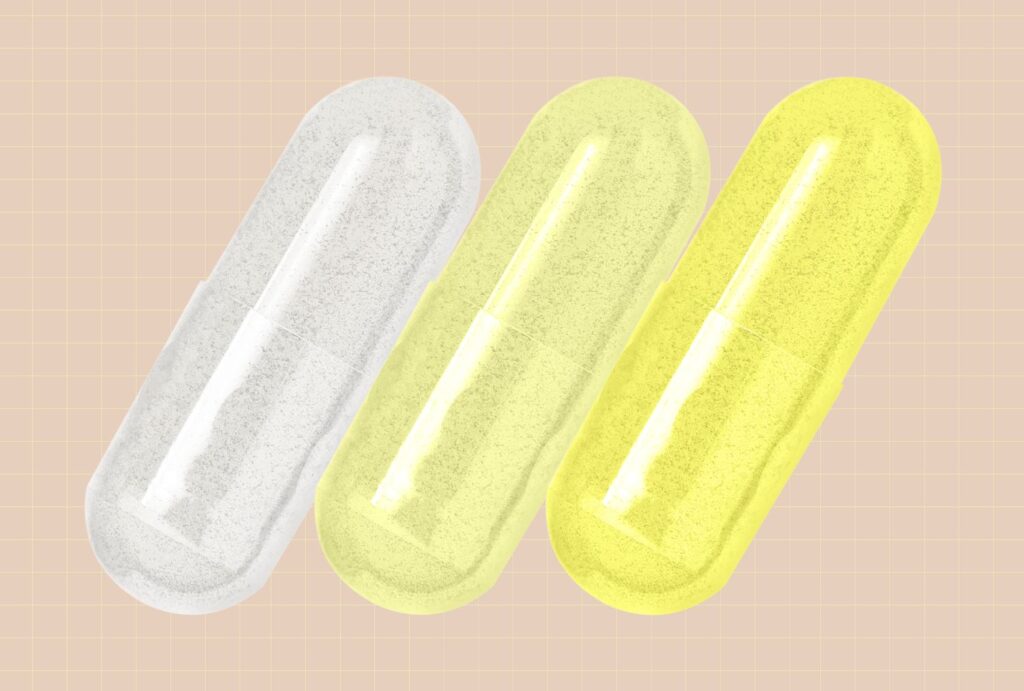- Bright neon-yellow pee is usually from taking too much riboflavin (vitamin B2) from supplements.
- Sometimes supplements may contain other ingredients like vitamin C, beet powder or dyes that can change urine color.
- If you notice sudden changes, like red or dark brown urine, visit a health professional.
If you look in the toilet after you pee—which I actually encourage—you may be surprised to see what looks like a melted yellow highlighter in the bowl. That neon color obviously didn’t come from a marker, but more likely from one of your vitamins.
“Riboflavin, or vitamin B2, causes bright yellow urine because it is actually a yellow-colored compound,” notes Andrea McCollum, M.B.A, RD. Certain supplements, especially riboflavin and other water-soluble vitamins, can change the color of your pee. We asked dietitians to explain why it happens, what normal urine looks like and when it might be worth checking in with a health care professional.
Why Your Pee Turns Yellow with Certain Supplements
The most common culprit behind neon-yellow pee is riboflavin, or vitamin B2. Naturally yellow, riboflavin is even fluorescent under ultraviolet light. “When your body takes in more riboflavin than it needs, the extra is flushed out through your urine, and because it’s a strong color, it can make your pee look bright or even neon yellow,” says Isabella Swiecicki-Allen, RD.
“Some other water-soluble vitamins can also cause some discoloration when they’re taken in excess, but they really don’t compare to the discoloration caused by vitamin B2, or riboflavin specifically,” adds McCollum.
Riboflavin may be taken on its own, as part of a B-complex supplement or in a multivitamin. Since B vitamins are water-soluble, your body doesn’t store large amounts, so it excretes what it doesn’t need. That’s why it’s important to get B vitamins—including riboflavin—through your diet every day. Fortunately, it’s found in many common foods, such as fortified cereals, oats, steak and dairy products, making it easy to get into your diet.
If you’re already meeting your riboflavin needs through food, taking a supplement can give you more than your body requires. Many multivitamins and other supplements can deliver 100% of your daily needs—1.3 milligrams for men and 1 mg for women—so the extra is simply excreted in your urine.
Should you be worried? For most people, no. “This yellow coloration is not considered to be dangerous,” adds McCollum. Since it’s a water-soluble vitamin, any excess is removed through urine. Still, it’s best to stay within the recommended daily limits unless your health care provider advises otherwise.
Other Supplements That Can Change Pee Color
While riboflavin is the most common cause of brightly colored urine, other compounds found in foods and supplements can also have an effect, including:
- Vitamin C. Swiecicki-Allen notes that high doses of vitamin C may darken urine or give it a slight yellow-orange tint, which may be more noticeable when you’re dehydrated.
- Beta-carotene: Beta-carotene, which gives carrots and sweet potatoes their orange color, has been known to give the skin a yellow-orange pigment if eaten in excess and may also slightly color your urine.
- Beetroot. Beets contain water-soluble compounds known as betalains, which give them their rich reddish-pink color. Supplements made with beet powder may cause your pee to turn a similar pinkish-red shade—a phenomenon known as beeturia—just like how this may happen from eating a meal containing beets.
- Methylene Blue. Methylene blue is sometimes added to unregulated traditional remedies for its vivid color, and is marketed in supplements claiming to “enhance mitochondrial efficiency,” although no scientific evidence supports these uses. In some cases, overuse of products containing methylene blue may tint urine a blue or green color.
- Other Edible Dyes. Certain supplements or foods may contain dyes that can change urine color.
What Is “Normal” Urine Color?
For healthy individuals, urine color is often influenced by hydration status, food, beverages or supplements. “What we want is to make sure we’re drinking enough, so shooting for a pale yellow urine is good when it comes to hydration status,” says McCollum.
When you’re dehydrated, urine may appear dark yellow or amber because it’s more concentrated. Staying hydrated is important for overall health, including proper kidney and bladder function. Checking the color of your urine can be a simple way to monitor your water intake and know when it’s time to drink up.
When to Speak to a Health Professional
Although bright yellow pee from riboflavin is usually harmless, changes in your urine color can sometimes signal a more serious health issue, such as kidney or liver problems or an infection. If you notice any of the following symptoms, it’s a good idea to consult your health care provider:
- Red or blood-colored urine
- Deep brown, tea-color or cola-colored urine
- Urine that is cloudy or frothy
- You experience pain or burning while urinating or notice a strong odor
- Sudden changes to your urine but you haven’t changed your diet or supplements
Our Expert Take
Bright yellow pee can be surprising the first time you see it, but if you’re taking a supplement containing riboflavin (vitamin B2), it’s simply your body flushing out any excess. “If you feel like you’re wasting your vitamins when you see that bright yellow, just know your body is doing its job and it’s absorbing what it needs,” states McCollum. Other supplements, medications or even foods—like beets or artificial dyes—can also change the color of your urine.
To stay on top of hydration, aim for urine that is pale yellow. Checking your urine can also help you spot more serious health issues, such as blood in your urine, which is a sign you should consult a health care professional.

